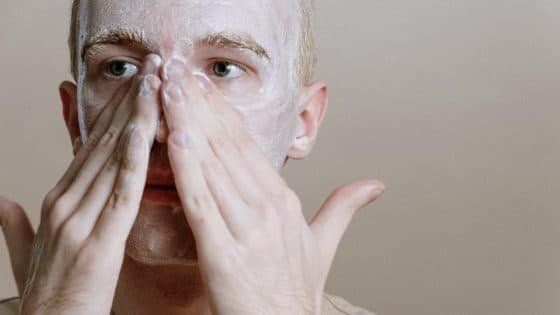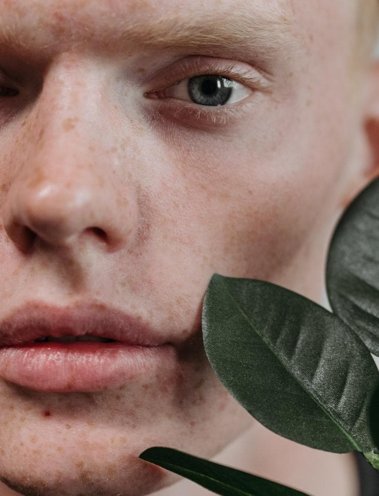Facial Treatments For Men: The DIY Guide

Men’s facials are underrated – blame stock photography for misrepresenting them for years. Facials for men are more than blue face masks, towel-wrapped heads and cucumber slices. And they offer a multitude of benefits for both women and men. However, some might argue that men need them because of the structure of their skin (more on that below).
Facial treatments for men require you to dedicate some time to focus on your skin and cater to its needs. Plus, they provide you with a few moments of respite to indulge yourself. “I think we all need to take a little bit of time to de-stress,” says Clarins Commercial Training Manager Jason Roberts. “Investing in self-care can promote well-being.”
Read on to discover everything you need to know about men’s face treatments, including our DIY guide on how to do a facial at home.

Are facial treatments for men different?
Facials for men are slightly different as the structure of a man’s skin is different from a woman’s skin. The uppermost layer (the epidermis) is about 25% thicker. “This is good in some ways because it makes it more resilient,” says Charlotte McHale, Clarins Training Manager. “But because it’s thicker, it needs a bit more energy to get the oxygen around and get the blood circulating well. So, it can look dull easily.”
Additionally, male skin also produces more sebum than female skin, leading to congestion and breakouts. Plus, shaving regularly acts as an added skin aggressor.
In conclusion, men can benefit from treating themselves to a skin-stimulating facial every few weeks. Can’t make it to a spa or salon? Here’s how to conduct a men’s facial treatment from the comfort of your home.
A step-by-step guide to a DIY facial treatment for men
Step one: cleanse
You want to start with a clean canvas. Avoid cleansers that are harsh or drying. The
Step two: exfoliate
Exfoliating should be part of your skincare routine, ideally two times a week. “Men’s skin requires more exfoliation because of the thicker epidermis and build up of dead surface skin cells,” says McHale.
As part of your men’s facial, add this step right after you cleanse. You could even club the cleansing and exfoliating steps with a product like the
Step three: mask
Masks are a great way to target specific concerns. Plus, they can mean that you sit still, possibly without your device, for 15 minutes – well, that can only be a good thing.
If excess oil, blemishes, blackheads, whiteheads or general skin congestion are your woes, try the
If you don’t need a clay mask, use this step to boost your skin’s hydration levels. “Men’s skin gets dehydrated quite quickly due to its structure,” explains Jason Roberts, Clarins Commercial Training Manager. “Also, the male hormone testosterone weakens the skin’s ability to lock in water.” To combat that, he recommends the
Step four: moisturise
Now, time to flood the skin with moisture, which is essential for healthy, glowing skin. You could use a
Don’t forget your eye care! Ideally, apply your eye cream before your moisturiser by gently dabbing it along the eye contour with your finger. Soft patting motions with your ring finger (your weakest finger) work best.
Step five: massage
“Facial massage and lymphatic drainage can both help to improve skin’s firmness, circulation, depuff and tighten the facial features,” says Lucy McClure, Clarins Training Development Manager – Treatments. “You can also use sculpting tools such as a
McClure shares some useful techniques you can try:
● Light tapping movements under the eyes, working outwards toward temples, stimulate circulation and reduce the signs of fatigue.
● Light tapping movements over the whole face before applying moisturiser to boost circulation and revitalise the complexion.
● To define the jawline, create a “V” with your index finger and middle finger and place them on either side of the jawline and lightly drain from chin to ear around ten times.
Not only will a facial massage feel ultra-relaxing, but it also boosts circulation. The result? A post-facial glow.
Men’s facial treatments to remedy specific skin concerns
Razor burn
Treating razor burn is mainly about being gentle, applying emollients and avoiding any alcohol-based products in the affected area. But prevention is the best option here, so add a few extra steps to your shaving routine.
“It’s important to protect the skin while shaving,” says McHale. “Layering products to protect the skin’s barrier is a great idea. So before shaving, massage in an oil (like the
She adds: “When you apply the foam, go against the hair growth, so it gets around each hair. Then, shave in the direction of the hair growth. Finally, follow it with the
Tip: Make sure to
Ingrown hairs
The shaving routine detailed above will also help prevent ingrown hairs – the red, itchy spots that can appear after shaving.
If you’re prone to getting ingrown hair post-shave, a quick
Dullness
“Men’s skin can be quite sluggish in terms of cell renewal, which is why men can suffer from more fatigue on the skin,” explains Roberts. A dull, lacklustre complexion is usually the result.
We can’t stress the importance of exfoliating enough for this, too. “It’s about removing dead skin from the surface – that’s usually what makes you dull,” explains McHale.
She also recommends the
Shop related products
The ClarinsMen Super Moisture Balm is an intense moisturiser for dry skin designed specifically for men. Protect and moisturise your skin in all conditions.
